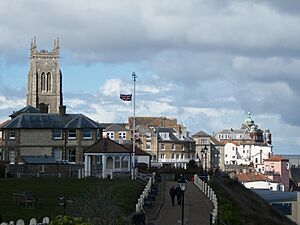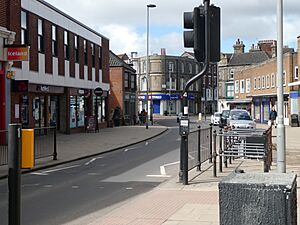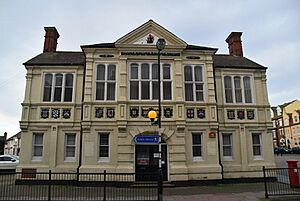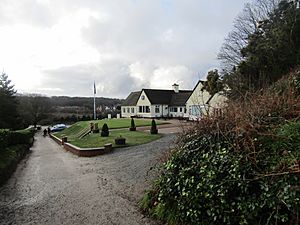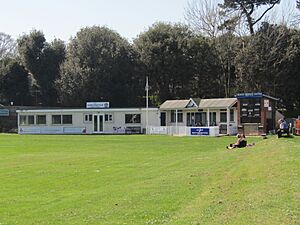Cromer facts for kids
Quick facts for kids Cromer |
|
|---|---|
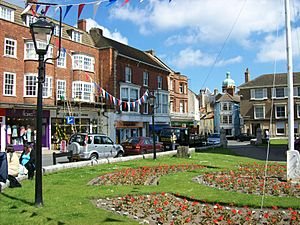 Church Street, Cromer (2012) |
|
| Area | 4.66 km2 (1.80 sq mi) |
| Population | 7,683 (2011 census) |
| • Density | 1,649/km2 (4,270/sq mi) |
| OS grid reference | TG219422 |
| Civil parish |
|
| District | |
| Shire county | |
| Region | |
| Country | England |
| Sovereign state | United Kingdom |
| Post town | CROMER |
| Postcode district | NR27 |
| Dialling code | 01263 |
| Police | Norfolk |
| Fire | Norfolk |
| Ambulance | East of England |
| EU Parliament | East of England |
| UK Parliament |
|
Cromer is a town on the coast of Norfolk, England. It's about 23 miles (37 km) north of Norwich. The town is located right on the North Sea coastline.
Cromer is famous for two main things: it's a popular place for tourists to visit, and it's known for its delicious Cromer crabs. These crabs are a big part of what local fishermen earn their living from. The town's motto, "Gem of the Norfolk Coast," shows how special it is.
Contents
History
Cromer is so old that it's not even mentioned in the Domesday Book from 1086. The name 'Cromer' probably means 'Crows' lake'.
Long ago, part of the old town, called Shipden, disappeared under the sea. Today, you can't see the old church tower that used to mark its spot. In 1888, a small boat hit the remains of the church, so the rock was blown up to make the area safer.
Cromer became a popular holiday spot in the early 1800s. Rich families from Norwich would spend their summers here. Even future King Edward VII visited and played golf! The famous Cromer Pier was built in the late Victorian times and has a theatre.
In 1883, a journalist named Clement Scott wrote about Cromer and the nearby coastline. He called it "Poppyland" because of all the poppies growing there. His writings, along with the new railway, brought many more visitors to the town.
During Second World War, Cromer was bombed several times. In 2013, a big storm surge damaged the pier and seafront. In 2016, the Cromer shoal chalk beds, which are Europe's largest chalk reef, became a special protected area called a Marine Conservation Zone.
Economy
Cromer has always been a fishing town. For centuries, fishermen caught crabs, lobsters, and herring. Today, it's mostly known for the famous Cromer crab. About ten boats still go out from the beach to catch crabs and lobsters. You can buy fresh crab from shops in town when the boats come in.
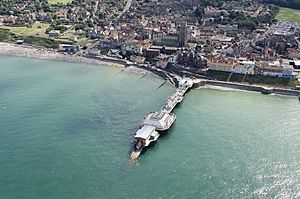
Tourism is also very important to Cromer's economy. People love to visit for beach holidays and to explore the area. The Cromer Pier and its Pavilion Theatre are big attractions.
Near the pier, you can find the RNLI Henry Blogg Museum. It tells the story of Cromer's lifeboats and the amazing rescues by Henry Blogg, one of the most famous lifeboatmen ever.
If you like animals, the Amazona zoo park is just outside town. It opened in 2006 and has animals like jaguars and pumas.
Culture and community
Every August, Cromer celebrates its Carnival Week. It's a fun event with a carnival queen, a street parade, and a fancy dress competition. The carnival celebrated its 50th anniversary in 2019!
Cromer is twinned with two towns: Nidda in Germany and Crest in France. This means they have special friendly connections.
The town has a Friday market where you can find local goods. Cromer Hospital provides healthcare for the area, including a unit for minor injuries.
The Cromer Museum, located in old fishermen's cottages, tells the story of the town. It has exhibits about the photographer Olive Edis and even parts of a West Runton Mammoth fossil!
Landmarks
Cromer is surrounded by tall coastal cliffs, some reaching up to 70 meters (230 feet) high. These cliffs are famous for their Pleistocene fossils. In 2017, a prehistoric rhino fossil, dating back 700,000 years, was found nearby!
Cromer Pier is a main feature of the seafront. It's 151 meters (495 feet) long and was built in 1901. It's home to the Pavilion Theatre.
Cromer Lighthouse stands on the cliffs east of town. It's 18 meters (59 feet) tall and its light can be seen from 21 nautical miles (39 km) away.
The Church of St Peter and St Paul is in the town center and dates back to the 1300s. Its bell tower is the tallest in Norfolk, standing 158 feet (48 meters) high. The church also has beautiful stained glass windows.
The Hotel de Paris was built in 1820 as a home and later became a hotel. It has great views of the pier. Other old hotels include the Red Lion Hotel and the Cliftonville Hotel.
Cromer Hall is a large house south of town. The original hall burned down and was rebuilt in 1829 in a Gothic Revival style. In 1901, the famous author Arthur Conan Doyle (who wrote the Sherlock Holmes stories) stayed here. After hearing local legends about a ghostly black dog called the Black Shuck, he was inspired to write his famous novel, The Hound of the Baskervilles!
The Old Town Hall was finished in 1890 and used to be a main place for public events.
Lifeboat station
Cromer has a very important lifeboat station, which was started in 1804. The fishermen in Cromer often volunteer to be part of the lifeboat crew. The most famous lifeboatman was Henry Blogg, who saved many lives and received several bravery medals.
Today, the lifeboat station has two lifeboats: one that goes far out to sea from the pier, and a smaller one for rescues closer to shore. They perform many rescues each year, helping people in trouble along the coast.
Transport
Cromer railway station is on the Bittern Line. Trains run regularly between Cromer and Norwich and Sheringham.
The railway first came to Cromer in 1877. There used to be two stations, but now only one remains, simply called 'Cromer'. In the past, you could even get direct trains from big cities like London and Manchester. Cromer also had the only railway tunnel in Norfolk, which is now closed.
Buses connect Cromer to nearby towns like Norwich, Sheringham, and Holt. Major roads like the A140 link Cromer to Norwich.
The closest airport is Norwich International Airport. There's also a small private airfield called Northrepps Aerodrome nearby.
Education
Cromer Academy is the main secondary school in town for students aged 11 to 16. For older students (sixth-form), they usually travel to schools in Sheringham or Norwich. Cromer also has a junior school and an infants school for younger children.
Media
For local news and TV, people in Cromer watch BBC East and ITV Anglia.
Local radio stations include BBC Radio Norfolk, Heart East, and Greatest Hits Radio East. There's also a local online station called Poppyland Community Radio.
The local newspapers are the North Norfolk News and the Eastern Daily Press.
Sport and leisure
Cromer has many sports clubs and places to have fun. The Royal Cromer Golf Club, founded in 1888, is on the cliffs. It's one of the oldest golf clubs in Norfolk.
Cromer Cricket Club plays at The Norton Warnes Cricket Ground. They have adult and junior teams.
Cromer Town F.C. is the local football club, and they have played at Cabbell Park since 1922. The town also has tennis and squash courts open to everyone.
The Norfolk Coast Path goes through Cromer, and the Weavers' Way walking trail ends here. There's also a 92-mile (148 km) cycle path along the coast.
Sea angling (fishing) is popular from the beaches and the pier. You can catch fish like cod and bass. The North Norfolk Surf Lifesaving Club is on the promenade, and you can also go Surfing near the pier.
International relations
Cromer is twinned with:
Notable people
- Edward Bach, who created Bach flower remedies
- Henry Blogg, a very brave lifeboatman
- Emily Wilding Davison, a women's rights campaigner
- James Dyson, who created Dyson vacuum cleaners
- John Hurt, a famous actor who lived nearby
- Malcolm Sayer, a designer for Jaguar cars
- Simon Thomas, a TV presenter
- Liam Walsh, a boxer based in Cromer
Images for kids
-
Aerial view of Cromer Pier (2015)
See also
 In Spanish: Cromer para niños
In Spanish: Cromer para niños




